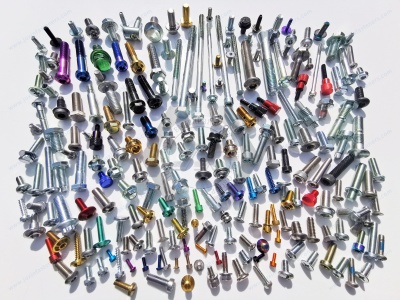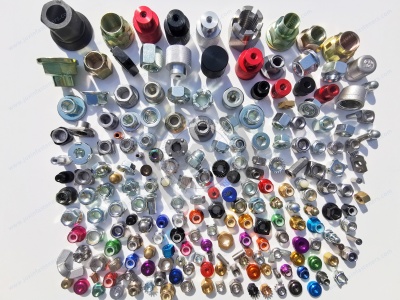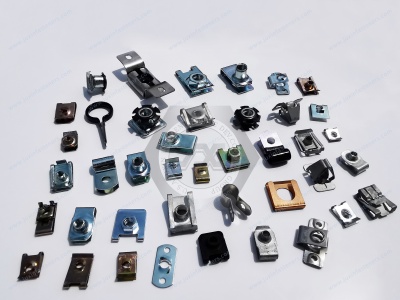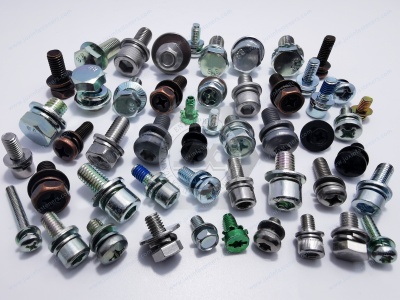Call Us
+86 136 6007 9809
Call Us
+86 136 6007 9809
Nov. 16, 2024
Friction Coefficient of Fasteners and Its Influencing Technologies
Torque Calculation Formula for Bolted Connections in VDI 2230
The formula for calculating tightening torque is as follows
Tightening Torque Formula:
MA=Fv⋅(d2⋅μt+0.5⋅d⋅μg)M_A = F_v \cdot (d_2 \cdot \mu_t + 0.5 \cdot d \cdot \mu_g)MA=Fv⋅(d2⋅μt+0.5⋅d⋅μg)
Where:
MAM_AMA: Tightening torque (Nm)
FvF_vFv: Bolt preload (N)
d2d_2d2: Nominal thread diameter (m)
μt\mu_tμt: Thread friction coefficient
ddd: Average diameter of the bolt head or nut contact surface (m)
μg\mu_gμg: Friction coefficient of the nut bearing surface or bolt head bearing surface
Preload FvF_vFv:
Preload is typically calculated based on the bolt material's yield strength and a design safety factor, ensuring it meets the mechanical requirements during assembly and operation:
Fv=α⋅As⋅RpF_v = \alpha \cdot A_s \cdot R_pFv=α⋅As⋅Rp
Where:
α\alphaα: Tightening factor (commonly 0.6–0.8)
AsA_sAs: Effective stress area of the bolt
RpR_pRp: Yield strength of the bolt materia
The friction coefficients are determined by surface properties such as roughness and lubrication.
Typical values:
μt\mu_tμt: 0.1–0.2
μg\mu_gμg: 0.08–0.18
Importance of the Friction Coefficient:
The friction coefficient is dimensionless and derived from physical measurements, influenced by the type and geometry of contact surfaces. It plays a critical role in determining the required tightening torque to achieve a consistent preload. Variations in the friction coefficient necessitate adjustments in torque values for consistent assembly outcomes.
Surface Treatment Processes Influencing Friction Coefficients:


The surface treatment of fasteners is a key factor in controlling the friction coefficient. Below are processes that affect friction coefficients:
1. Electroplating and Sealing
Sealing agents, also known as brighteners, consist of organic corrosion inhibitors, surfactants, and water-soluble polymers. They form a dense and uniform film after curing, enhancing corrosion resistance, surface smoothness, and brightness.
Process Flow:
Electroplating → Washing → Brightening (for zinc plating) → Washing → Passivation → Washing → Sealing → Drying
Key effects:
Sealing agents with added lubricants can adjust the friction coefficient.
Friction coefficients should ideally range from 0.09–0.15 for optimal material utilization.
Factors affecting friction coefficient:
Concentration of lubricant in the sealing agent
Centrifuge speed, drying time, and loading capacity
Curing temperature and handling during the process
2. Zinc-Aluminum Coating (Top Coating)
Zinc-aluminum coating, also known as environmentally friendly Dacromet, provides a multilayer corrosion-resistant coating of fine zinc and aluminum flakes.
Process Flow:
Degreasing → Mechanical Blasting → Base Coating (2x or 3x) → Baking → Top Coating (1x or 2x) → Baking → Post-Treatment
Key effects:
Top coating with lubricants adjusts the friction coefficient.
Excessive centrifuge speed or baking temperature can thin the coating and increase friction.
3. Phosphating
Phosphating forms a phosphate conversion layer through chemical reactions, often followed by oiling for lubrication.
Process Flow:
Degreasing → Washing → Pickling → Neutralizing → Phosphating → Rinsing → Drying → Oiling
Key effects:
Phosphating ensures consistent torque-preload relationships, widely used in structural steel connections and high-strength bolts to prevent hydrogen embrittlement.
Adding lubricants to the oil ensures stable friction coefficients.


4. Electrophoretic Coating
Electrophoretic coating involves depositing charged paint particles onto a surface under an electric field, forming a protective film.
Process Flow:
Pre-Treatment (e.g., pickling, blasting, or phosphating) → Electrophoresis → Rinsing → Sealing (to adjust friction) → Baking
Key effects:
Friction coefficient depends on the paint properties and pre-treatment processes.
Post-treatment sealing with lubricants adjusts the coefficient as needed.
By understanding and controlling these processes, manufacturers can ensure fasteners' consistent performance, meet the desired assembly requirements, and enhance product reliability.
Contact Us
Tel.:
+86 020 8621 0320
+86 020 3121 6067
Technical Support:
Navigation
SEND INQUIREY